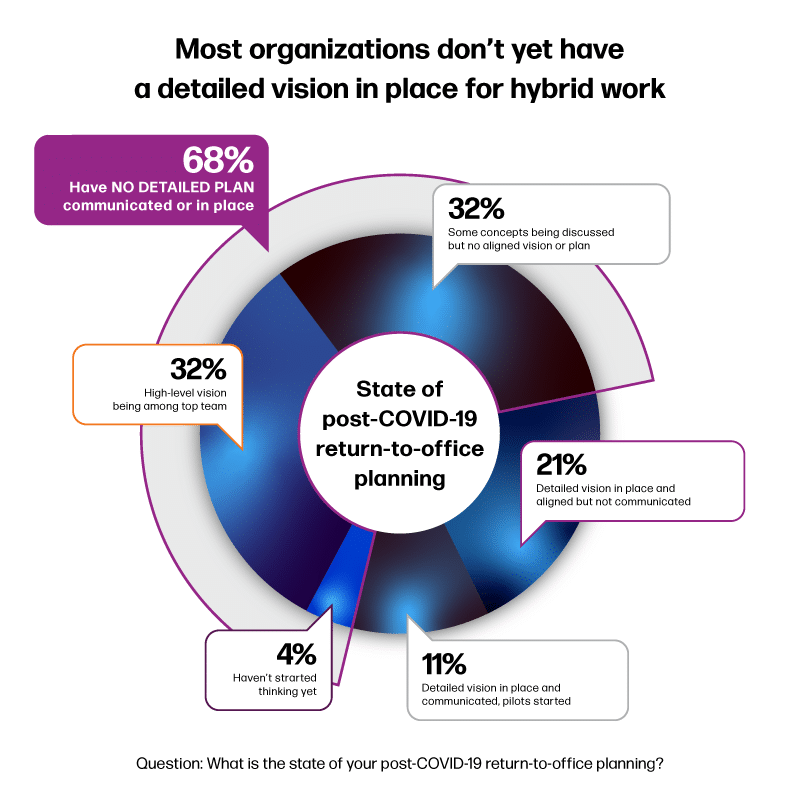June 24, 2021
Catherine Daly
5 Tips for Managing Hybrid and Remote Teams
5 minutes
Some of your employees feel a tinge of existential dread when they hear the phrase “return to office.” That’s because they’ve learned that their workspace and living space can co-exist peacefully, and no one’s mistakenly eating their yogurt in the office fridge.
Before the pandemic, remote work was something only a minority of the workforce enjoyed. Now, the hybrid workplace is termed “the future of work.”
According to McKinsey, nine out of ten organizations will adopt a blend of remote and on-site working in the future—even though most don’t have a detailed plan in place to support hybrid teams.
For the people responsible for managing hybrid and remote teams, checking in on their teammates’ workload and wellbeing is no longer as easy as a casual conversation by the coffee machine.
→ Download Now: The Essential Guide to the Hybrid Workplace
Remote workers have different needs than office workers, and this means a different management approach to everything from onboarding and check-ins to collaboration and personal development.
In this article, we’ll share several tips and tools to help you manage the workforce of the future.
Table of contents
- What is a Hybrid Team?
- Tips for Managing Hybrid and Remote Teams
- The Best Tools for Managing Hybrid and Remote Teams
What is a Hybrid Team?
A hybrid team is a working team that operates both remotely and co-located in physical office spaces. This can mean some employees are fully remote at all times, some spend their workdays in physical office locations, and some have the flexibility to transition between remote and in-person work.
The benefits of a hybrid team structure include:
- Lower operational costs associated with physical offices
- Increased employee flexibility and autonomy
- Access to a diverse global talent pool
- Inclusive opportunities to collaborate
- Happier employees
Hybrid teams will only work when combined with the right resources, technology, and support.
5 Tips for Managing Hybrid and Remote Teams
Managing hybrid and remote teams creates several challenges for managers. In a recent Harvard Business Review survey of managers, 40 percent said they doubt their ability to manage remote staff. Here are five ways managers can set hybrid and remote teams up for success:
1. Focus on Inclusion
The employee experience should be the same—whether you’re in an office one day a week, five days a week, or never. However, creating an inclusive environment is complicated with a distributed team.
A Harvard Business Review study revealed that “many (remote workers) feel their colleagues don’t treat them equally.” Making hybrid and remote teams successful requires a complete shift in organizational behavior, so remote workers never feel like they’re less recognized for their contributions.
Restructure your workplace culture to accommodate all employees. For example, make meetings less office-centric by making everyone—even in-office staff—attend virtually. It’s hard to get involved in side chatter when you’re remote. If everyone attends the meeting virtually, everyone feels included in the pre-meeting small talk.
2. Adopt flexible working arrangements
Remote employees keep different schedules to in-office employees— but that doesn’t mean they’re not working as hard. It’s important to shift the focus from the old time-keeping processes to actual results.
Find out what times and work patterns work for different team members and set expectations that align with them.
For in-office employees, create work environments that reflect how they actually operate. For example, if some employees sit in the cafeteria because they prefer background noise to the solitude of their office, create more open-plan spaces.
3. Close communication gaps
Managing hybrid and remote teams requires a different approach to communications. While text, email, and Zoom calls are great for work, in-person connections are great for building emotional connections.
Bring teams together in person from time to time. Face-to-face interactions create more opportunities for rich, informal interactions that can help build trust and culture. After all, a lot of our communication is non-verbal.
4. Encourage transparency
One of the biggest barriers to the success of hybrid and remote teams is a lack of trust. Many managers still have an unconscious bias that the people they physically see in the office work harder than those at home. Encourage remote workers to be visible, open, and communicative without making them feel like you’re micro-managing.
A culture of openness will reduce the potential for conflict among team members, as it breeds collaboration rather than competition.
5. Monitor stress levels
Hybrid and remote work models mean that work lives and personal lives are more blended than ever before. Pay attention to your team and watch for signs of burnout. If you notice that someone is behaving differently—maybe an employee is quieter than usual or more irritable—it is probably a sign of stress.
Talk to employees one-on-one and help them to prioritize their workload, introduce some playfulness into the workday, and encourage them to take vacation days when they need them.
The Best Tools for Managing Hybrid and Remote Teams
In addition to adopting new management styles, you can introduce some new tools to make hybrid and remote teams happier and more productive.
1. Project management tools
Project management tools help bring order and accountability to hybrid teams. Monday.com, Asana, and Hive are just some project management tools that enable team members to track projects, assign tasks to others, and collaborate effectively from anywhere.
2. Collaboration tools
There are thousands of collaboration tools on the market to help with everything from organization (Trello and Google Drive) to communication (Zoom and Google Meet).
3. Physical tech
Whether someone is working in-office or from home, their physical office space will impact their productivity. Consider investing in tools like professional cameras and microphones for videocalls or standing desks.
4. Discussion management
Discussion management solutions like ThoughtExchange are critical in helping us connect to our hybrid teams. Managers can quickly check in with distributed teams, provide an unbiased space for innovation, and keep track of the conversations that matter. Unlike a survey tool or a poll, an Exchange begins with an open-ended question that your team submits responses to anonymously.
The Future of Work is Hybrid
By considering the needs of hybrid, remote, and in-office staff, you can find a balance that helps all workers do their work the best way they can.
Get started by discovering what some of those needs are with an enterprise discussion management tool like ThoughtExchange.






